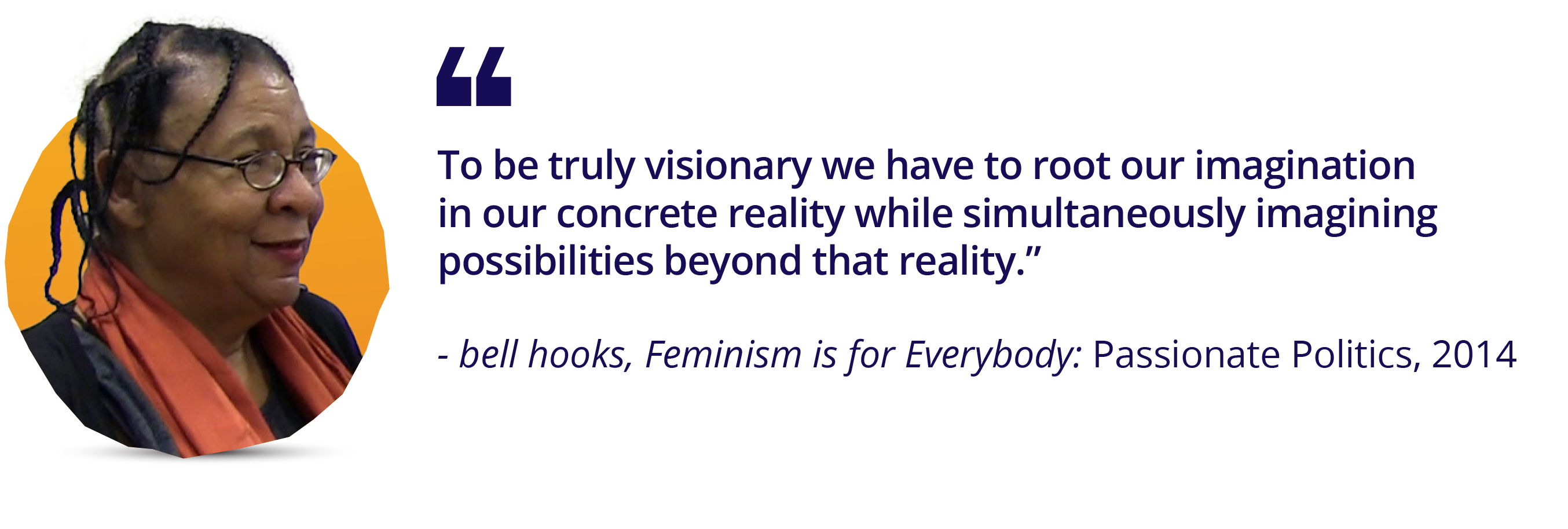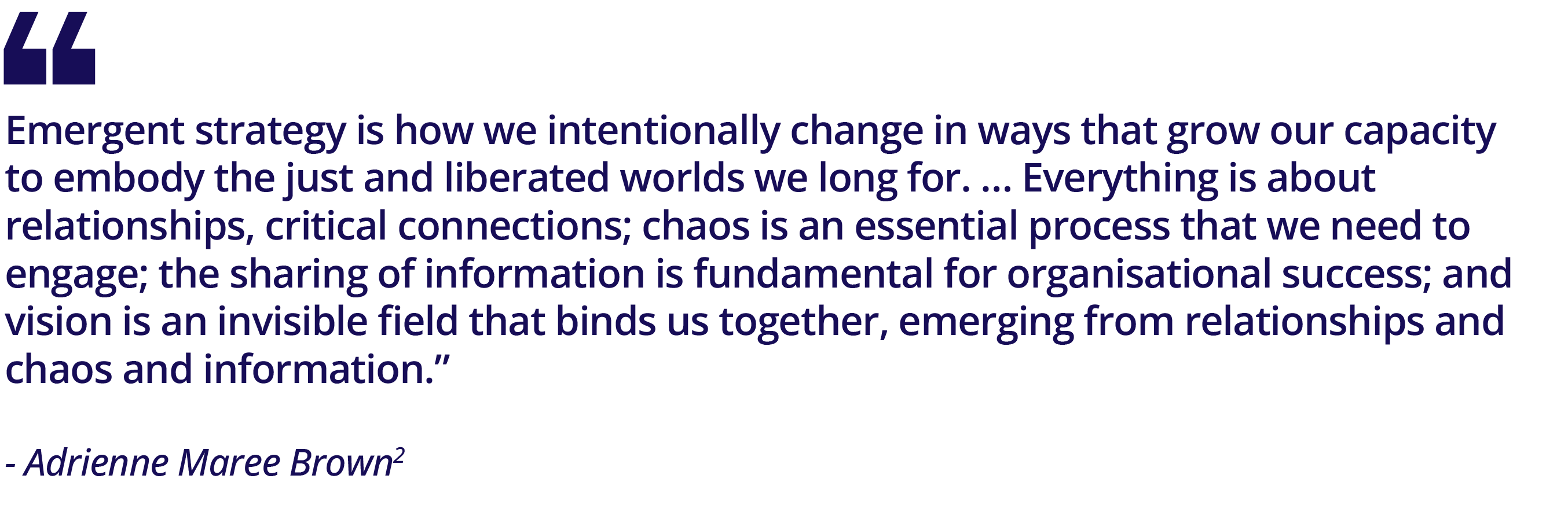Core Ideas
Strategies for movement building
Any strategy includes short- and medium-term processes and actions in pursuit of long-term goals. A movement-building strategy specifies how organising, leadership-development, alliances and joint action build capacity and community over time to advance the values and vision that center justice and belonging. In a context of constant flux, think of strategy as the compass that orients decision-making and informs short-, medium-, and long-term actions and processes.

Movement strategy depends upon five components:
- Creating a shared guiding vision of change;
- Understanding context, moment and power;
- Articulating a bold ambition and agenda;
- Forging a sense of common ground, community, and belonging; and
- Building and leveraging leadership and organising capacity, clout, resources, and alliances.
A movement ecosystem
Depending on the moment and context, different forms of engagement make sense. At times, strategies to reform visible power and formal structures (policy, laws, budgets, elections, etc.) may be key, at other times they are either too risky or not likely to produce the change we want. Some movements will focus on other ways to contest power – resisting and exposing powerful interests, re-imagining and reclaiming alternative ways of living, creating sovereign and autonomous spaces, or blocking or shutting down oppressive systems. For any of these approaches to deliver social and political change, narrative strategies are vital to legitimise agendas and broaden popular support and momentum.
All of these strategies can co-exist in a movement ecosystem. They can be complementary or merely parallel. Intentional alignment and complementarity are powerful. Ask yourselves:
- Where does your organisation sit within a larger movement ecosystem of organisations and individual change-makers and activists?
- What do you and your organisation bring to this ecosystem?
- With whom might you find common purpose or align?
- How can you harness collective efforts for greater impact?

Essential movement strategies
Organise and educate: Organising is about bringing people’s concerns, dreams and indignation together into a collective organised force for change. Deep dialogue and collective learning (for example through Feminist Popular Education) mixed with new types of knowledge are central to building individual and collective leadership and common agendas. Organising and educating help establish trust and cohesion across differences to create an energising bond and a liberatory force. Organising builds the essential base and constituencies to drive and embody change over time.
Reform and engage: These strategies aim to change specific laws and policies and their enforcement in order to stop harms, address structural discrimination, redirect resources, and better serve all people, the planet, and our future. We campaign and engage in elections to promote leaders who are more representative and accountable. We go to court to block or address harm. We lobby and advocate to pressure decisionmakers on the specifics of policy and implementation. We may seek to change rules and practices within religious, educational institutions, civil society organisations, and corporations – not only governments.
Network and connect: Building a bigger ‘we’ – to leverage greater power – involves working with people and different kinds of organisations, some of whom may not agree with us on everything. Alliances demand trust building because of inevitable conflict over power, resources, visibility, representation, and values. Beyond our own groups, we can advance our agendas by building tactical alliances with key experts, researchers, and officials inside the structures of power.
Resist and expose: We can rally constituencies, allies and supporters by working with social media activists, journalists, and researchers, and through mobilisations to confront and expose injustice, corruption, and abuse of power. Challenging the legitimacy of the system – through civil disobedience, non-compliance, rejection of existing decision-making processes, and use of autonomous spaces or boycotts – are other ways to resist. Direct action such as protests, blockades, marches, boycotts and non-participation build public pressure, create opportunities for people to act on frustrations, and amplify our messages and demands.
Create and claim: Other strategies disengage with the state and visible power, and instead establish autonomous and sovereign spaces, such as cooperatives, commons, or self-defined or ancestral forms of community governance. Such independent initiatives enable communities to define and protect ways of life and economies that are aligned with their beliefs and values. Using media and messaging, they can share their example to inspire others and to shape narratives and public discussion about broader possibilities for change.
Narrate and communicate: We need to expose and challenge the dominant narratives that generate fear and polarise and dehumanise groups, and create our own narratives to offer alternative explanations and worldviews that centre life, care, dignity, and reciprocity. Communicating our narratives digitally – as well as via traditional media, popular culture, and face-to-face through dialogue and popular education – serves to connect a larger ‘we’. Symbolic and cultural change strategies can be demonstrated through art, songs, humour, theatre, poetry, and dance to build strength and convey alternatives.
Reimagine: Central to all these processes is the inspiring reimagined future that we seek. Individual and collective practices of radical imagination draw on our wisdom and values and beliefs to build a sense of purpose and power for social transformation.
No single organisation can do everything that is needed to transform power. In the constellation of actors, it is key to have organisers and it helps to have specialised capacities in support of frontline communities including legal and research aid, security, and media. The idea of the movement ecosystem situates our efforts in a larger agenda.
 The collaborative process of strategy development is an opportunity to deepen shared analysis and to build collective consciousness, political trust, and a sense of ownership.
The collaborative process of strategy development is an opportunity to deepen shared analysis and to build collective consciousness, political trust, and a sense of ownership.
Movement infrastructure
“Social movement infrastructure can be physical – the meeting spaces where people come together or the megaphones and equipment people use in the streets; movement infrastructure can be organisational – regular coordination spaces to engage in consultation and move work forward; and movement infrastructure can be intellectual – power mapping, databases, and contact lists… [it] can be relationships and networks – building alliances, facilitating conversations, aligning around collective demands…. (and) training new organisers. And more often than not, the strength of the movement infrastructure that is in place just before … trigger events take place can play an incredibly influential role in how high movements can ride waves of action and how far those waves can carry movements.” Movement Catalyst 1
Emergent strategy
Activists and scholars are generating fresh thinking about strategy that is better suited to our turbulent times than the results-specific strategic planning theories of an earlier era. These ideas consider the relational, contentious, zigzag nature of social change and power. For example, the activist and writer adrienne maree browne draws on patterns of nature and ecological systems to conceptualise “emergent strategy”.

Good strategy is about holding the realities of the present while imagining the future and weaving a bigger ‘we’ that can enable us to navigate the unexpected. Effective social change work demands agility – to be able to step into unexpected moments and opportunities to block or speak out against injustice or move a justice agenda forward. Our actions are never exactly as we plan – adjustments, learning and the unexpected shape fresh directions and offer new insights. Praxis – the habit of action–reflection–action – remains a crucial process.
Download handout: Core ideas.
______________________________
1 Building the Movement Infrastructure We Need in This Moment, Movement Catalyst, Medium. January 25, 2021,
2 adrienne maree brown, 2017. Emergent Strategy. Edinburgh, Scotland: AK Press.
